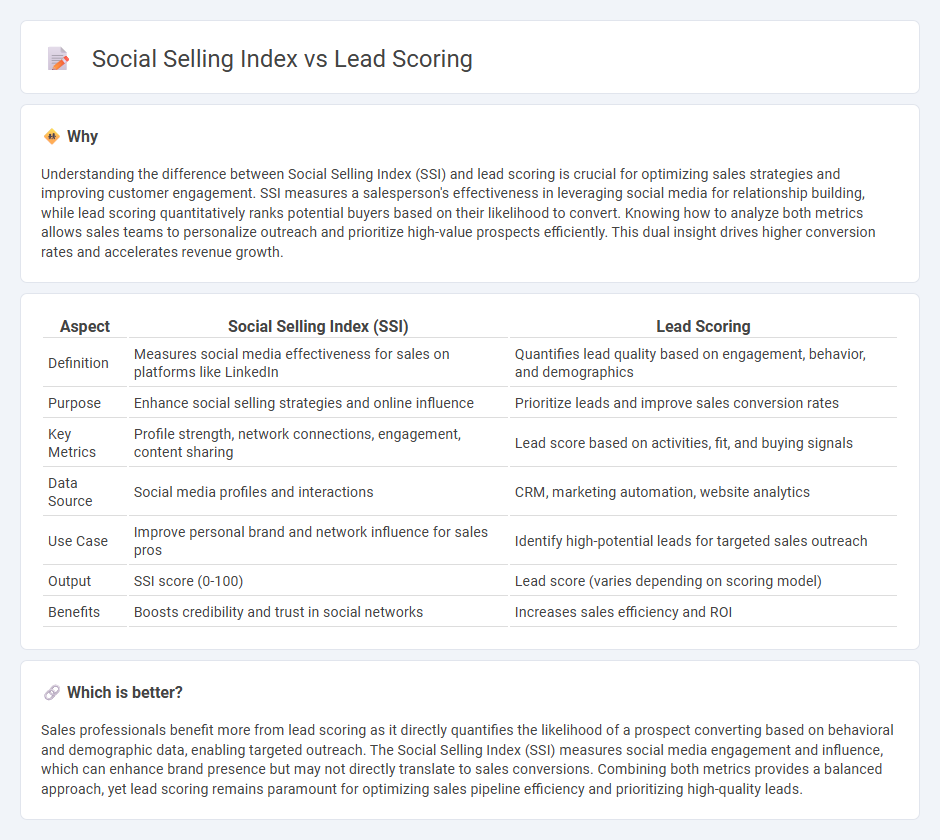
The Social Selling Index (SSI) measures a salesperson's effectiveness in leveraging social networks to build relationships and generate prospects. Lead scoring evaluates and ranks potential customers based on their engagement and likelihood to purchase, optimizing sales efforts toward high-value targets. Explore how integrating SSI with lead scoring can enhance your sales strategy and boost revenue.
Why it is important
Understanding the difference between Social Selling Index (SSI) and lead scoring is crucial for optimizing sales strategies and improving customer engagement. SSI measures a salesperson's effectiveness in leveraging social media for relationship building, while lead scoring quantitatively ranks potential buyers based on their likelihood to convert. Knowing how to analyze both metrics allows sales teams to personalize outreach and prioritize high-value prospects efficiently. This dual insight drives higher conversion rates and accelerates revenue growth.
Comparison Table
| Aspect | Social Selling Index (SSI) | Lead Scoring |
|---|---|---|
| Definition | Measures social media effectiveness for sales on platforms like LinkedIn | Quantifies lead quality based on engagement, behavior, and demographics |
| Purpose | Enhance social selling strategies and online influence | Prioritize leads and improve sales conversion rates |
| Key Metrics | Profile strength, network connections, engagement, content sharing | Lead score based on activities, fit, and buying signals |
| Data Source | Social media profiles and interactions | CRM, marketing automation, website analytics |
| Use Case | Improve personal brand and network influence for sales pros | Identify high-potential leads for targeted sales outreach |
| Output | SSI score (0-100) | Lead score (varies depending on scoring model) |
| Benefits | Boosts credibility and trust in social networks | Increases sales efficiency and ROI |
Which is better?
Sales professionals benefit more from lead scoring as it directly quantifies the likelihood of a prospect converting based on behavioral and demographic data, enabling targeted outreach. The Social Selling Index (SSI) measures social media engagement and influence, which can enhance brand presence but may not directly translate to sales conversions. Combining both metrics provides a balanced approach, yet lead scoring remains paramount for optimizing sales pipeline efficiency and prioritizing high-quality leads.
Connection
Social Selling Index (SSI) measures a salesperson's effectiveness in leveraging social networks to find and engage prospects, while lead scoring ranks potential customers based on their likelihood to convert. Integrating SSI data with lead scoring enhances targeting accuracy, as higher SSI scores often correlate with better engagement and lead qualification. This connection enables sales teams to prioritize leads more efficiently, boosting conversion rates and overall revenue performance.
Key Terms
**Lead Scoring:**
Lead scoring quantifies a prospect's likelihood to convert based on demographic attributes, behavioral data, and engagement history, enabling sales teams to prioritize high-value leads efficiently. By assigning scores to actions like email opens, website visits, and past purchases, businesses optimize resource allocation for faster deal closure. Discover how lead scoring enhances your sales strategy and boosts conversion rates.
Qualification Criteria
Lead scoring evaluates potential customers based on demographic, behavioral, and firmographic data to prioritize prospects most likely to convert, while the Social Selling Index (SSI) measures a professional's effectiveness in building relationships and brand presence on LinkedIn. Qualification criteria in lead scoring include factors like engagement level, budget, and decision-making power, whereas SSI focuses on social engagement, content sharing, and network growth. Explore further to understand how these metrics optimize sales strategies and improve lead qualification efficiency.
Behavioral Data
Lead scoring prioritizes behavioral data such as website visits, email interactions, and content downloads to rank potential customers based on their likelihood to convert. The Social Selling Index (SSI) measures professional brand effectiveness using LinkedIn-specific behaviors, including profile optimization, network growth, and engagement with relevant content. Explore deeper insights into how behavioral data drives lead prioritization and social selling effectiveness.
Source and External Links
What Is Lead Scoring? Definition, Models, Best Practices - Lead scoring is a method that assigns points to leads based on their behaviors and attributes to prioritize sales efforts on the highest-quality, most sales-ready leads, improving conversion rates and efficiency.
Lead scoring - Lead scoring ranks prospects on a scale reflecting their perceived value to an organization by combining explicit data (like job title, company size) and implicit data (like website visits), helping sales focus on the most promising leads and aligning sales with marketing.
The Ultimate Guide to Lead Scoring - Lead scoring involves systematically ranking potential customers by likelihood to purchase using behavior, engagement, and demographics, implemented through a step-by-step process that balances customer fit and engagement data for optimized prioritization.
 dowidth.com
dowidth.com